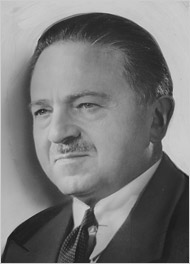Ely Jacques Kahn
| Ely Jacques Kahn | |
|---|---|

Historical photo of Ely Jacques Kahn
|
|
| Born | 1884 New York City |
| Died | 1972 New York City |
| Nationality | American |
| Alma mater | Columbia University |
| Occupation | Architect |
| Spouse(s) | Elsie P. Kahn |
| Children |
Joan Kahn Ely Jacques Kahn, Jr. Olivia Kahn |
Ely Jacques Kahn (June 1, 1884 – September 5, 1972) was an American commercial architect who designed numerous skyscrapers in New York City in the twentieth century. In addition to buildings intended for commercial use, Kahn's designs ranged throughout the possibilities of architectural programs, including facilities for the film industry. Many of his numerous buildings under the 1916 Zoning Resolution feature architectural setbacks to keep the building profitably close to its permitted "envelope" and have been likened to the stepped form of the Tower of Babell; a notable example is his 1400 Broadway (1931). Kahn is also known for his guidance to author Ayn Rand.
Kahn was born in New York, the only son of a prosperous Austrian and French-American Jewish family. His sister Rena Rosenthal brought design wares from Europe to sell in New York, perhaps providing his earliest introduction to design. Ely Jacques Kahn traveled to Europe where he was aware of the work of architect Josef Hoffmann. He attended Columbia University and later was a professor at Cornell University. Kahn was the father of noted New Yorker magazine writer Ely Jacques Kahn, Jr., and great-grandfather of Ely Jacques Kahn IV, former Director of Cybersecurity Policy at the White House.
Kahn's partnership with Albert Buchman lasted from 1917 until 1930. In this period his work alternated Beaux-Arts with cubism, modernism, and art deco, of which examples are 2 Park Avenue (1927), using architectural terracotta in jazzy facets and primary colors, the Film Center Building in Hell's Kitchen (1928–29) and the Squibb Building (1930), which Kahn considered among his best work. In what has become an iconic photograph, Kahn masqueraded as his own Squibb Building with other architects dressed as buildings for the Beaux Arts Ball of 1931. The building moved decisively away from the decorative modernity of the Art Deco 20s: Lewis Mumford praised it in 1931 as “a great relief after the fireworks, the Coney Island barking, the theatrical geegaws that have been masquerading as le style moderne around Manhattan during the last few years.”
...
Wikipedia
